![[Flag of Colombia]](../images/c/co.gif) (2:3)
(2:3)  image by Željko Heimer, 20 May 2001
image by Željko Heimer, 20 May 2001
Last modified: 2024-03-02 by rob raeside
Keywords: education |
Links: FOTW homepage |
search |
disclaimer and copyright |
write us |
mirrors
![[Flag of Colombia]](../images/c/co.gif) (2:3)
(2:3)  image by Željko Heimer, 20 May 2001
image by Željko Heimer, 20 May 2001
See also:
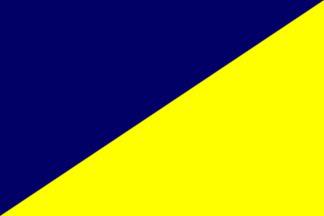 image by Ivan Sache, 10 September 2022
image by Ivan Sache, 10 September 2022
IEM Nacional was established on 20 January 1973 in Pitalito (Department of
Huila).
The flag of IEM Nacional, designed by teacher Armando Muñoz, is
divided blue-yellow from lower hoist to upper fly.
Blue symbolizes
intellectual skills, while yellow symbolizes horizon and future.
https://iemnacionalpitalito.edu.co/simbolos - School website
Ivan Sache, 10
September 2022
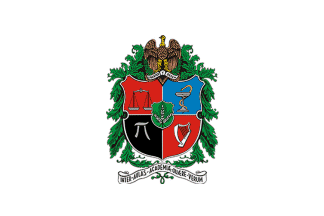 image by Randy Young, 07 February 2016
image by Randy Young, 07 February 2016
"Universidad Nacional de Colombia (English: National University of
Colombia), is a public, national, coeducational, research university,
located primarily in Bogotá,
Medellín,
Manizales and
Palmira, Colombia, with
other satellite locations in
San Andrés as well. Established
in 1867 by an act of the Congress of Colombia, the university is the
largest higher education institution of the country with more than
44,000 students, the largest number of graduated professionals per
year, and number of academic programmes at undergraduate and
postgraduate levels."
Source:
https://en.wikipedia.org/wiki/National_University_of_Colombia
For additional information go to UNAL (official website)
The flag is the
logo over a white horizontal flag as seen in
this video (at 18:01) by
CM& tv news:
Image is cropped image from video above.
Esteban Rivera, 07 February 2016
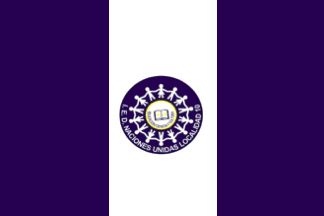 image by Ivan Sache, 13 May 2021
image by Ivan Sache, 13 May 2021
Colegio Naciones Unidas - Institución Educativa Distrital was established in borough Las Ferias, Engativá in 2003 as the merger of Centro Educativo Distrital Jairo Aníbal Niño and Centro Educativo Distrital Naciones Unidas. Centro Educativo Distrital Naciones Unidas was built in the 1950s with the support of the United Nations, which offered furniture, writing cases, desks and material for the cafeteria.
The symbols of Colegio Naciones Unidas - IED are prescribed in Chapter 1.1. of (most probably) the Manual de Convivencia.
1.1.1. Flag:
Composed of three vertical stripes, two lateral, blue and one white in
the center, charged with the IED's coat of arms.
Blue represents firmness, will, loyalty, wisdom and dedication to work.
White represents peace that reigns over the educative community.
1.1.2. Coat of Arms:
Composed of two concentric circles. In the center, a white circle with a
white book and a four-pointed star on each page, surrounded by the motto
"EDUCACIÓN, CIENCIA Y CULTURA" [Education, Science and Culture].
The open book means the encounter with knowledge and the star the goals
and excellence to be reached by the students.
In the outer part, a blue circle with a frieze composed of white
representations of boys and girls holding each other's hand, forming a
circle that symbolizes fraternity, peace, harmony and democracy that
should reign within the institution.
The lower part of the outer circle shall be inscribed with the name of
the institution "IED NACIONES UNIDAS. LOCALIDAD 10".
Sources: school website and school website
Ivan Sache, 13 May 2021
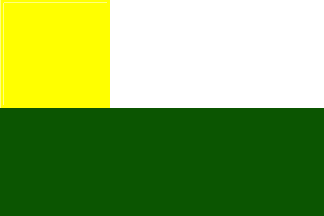 image by Ivan Sache, 21 August 2017
image by Ivan Sache, 21 August 2017
Instituciión Educativa Narciso Cabal Salcedo is located in Buga (Valle del
Cauca).
The flag of I.E. Narciso Cabal Salcedo is prescribed in Article 8
of the Manual de Convivencia (Version 5, 12 January 2017). The flag is made of
two horizontal stripes, the first, white with the third part [that is, a square]
at hoist yellow, and the second, green. Yellow represents the intellectual
resources constituting the educational community. White is a symbol of light,
purity, peace and clarity. Green is a symbol of kindness and justice,
representing force, hope, energy and vigor, and also the color the natural
environment surrounding the I.E..
Manual de Convivencia
Ivan Sache, 21 August 2017
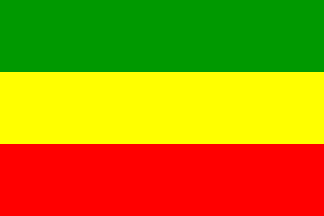 image by Ivan Sache, 28 July 2014
image by Ivan Sache, 28 July 2014
Universidad de Nariño is the descendant of a college founded
in 1712 by the Jesuits in San Juan de Pasto, to teach Latin,
Spanish and Religious History; the college was closed in 1767
when King Charles III decreed the expelling of the Jesuits from
America. The college reemerged in 1791 as Real Colegio Seminario,
transformed in 1822 into a military camp, PAsto supporting at the
time the Royalists. In 1827, the President of the Republic,
General Francisco de Paula de Santander, decreed the founding of
the Colegio Provincial; this was considered as a gesture of
reconciliation between the town and the power. The college was
renamed Colegio San Augustin in 1832, as a tribute to the
Augustinian monks that funded it. Colegio San Augustin is
considered as the true forerunner of the today's university.
Renamed Colegio Académico in the 1850s, the college was made a
university by Presidential Decree No 726 of 11 September 1889,
confirmed in 1894 by Decree No. 30 of the Assembly of the
Department of Cauca. The university was transferred to the newly
created Department of Nariño in 1904.
Source: University
website - History.
The symbols of Universidad de Nariño were adopted on 17 October
1979 by Decree No 478 of the university's Board.
The flag of Universidad de Nariño is rectangular, with
proportions 22:27 and usual size of 1.10 x 1.35 m. Made of three
equal horizontal stripes, green, yellow and red, and charged in
the middle with the university's emblem, the flag shall be
hoisted on a pole of 2.50 m in height.
The emblem of Universidad de Nariño, designed by Pr. Dr. Ignacio
Rodríguez Guerrero, includes the coat of arms granted to the
town of San Juan de Pasto on 17 June 1559, described as: "A
shield charged in the middle with a castle argent flanked by four
lions or, below the castle a river wavy azure and white flowing
between green trees, the field of the shield azure, the trees and
the castle on a field yellow and a soil green and or..." The
shield is surrounded by a yellow ring charged with the black
writing:
- top: "TANTVM POSSVMVS QVANTVM SCIMVS" ("We do
what we know", indeed, "Our capacity for action depends
on how much we know", a quote of Francis Bacon [1561-1626])
- bottom: "NIVERSITAS STVDIORVM NARIÑENSES" (bottom).
On the image, the name of the university is written as
"UNIVERSIDAD DE NARIÑO"
Source: University
website - Symbols.
Ivan Sache, 5 February 2010
The flag, at least in unofficial use, is not charged with the
university's emblem as officially prescribed, and has standard
proportions 2:3, instead of the prescribed, odd proportions 22:25.
Photo:
http://www.mineducacion.gov.co/cvn/1665/w3-article-289377.html
Ivan Sache, 28 July 2014
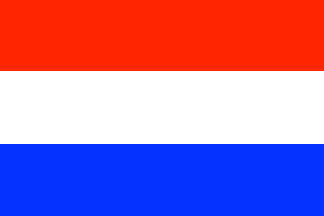 image by Ivan Sache, 11 September 2022
image by Ivan Sache, 11 September 2022
I.E. Navarra was established in 1990 in Navarra, a urban unit built in 1986
in Bello (department of Antioquia).
The flag of IE Navarra is
horizontally divided red-white-blue.
Red is a symbol of the educational
community's tenacity, force and integrity.
White is a symbol of peaceful
coexistence.
Red is a symbol of tranquillity and optimism.
http://www.ienavarra.edu.co/index.php/institucional/opcion - School website
Ivan Sache, 11 September 2022
 image by Ivan Sache, 1 January 2021
image by Ivan Sache, 1 January 2021
The flag of Gimnasio Mixto Nazareth is horizontally divided green-red with
the school's emblem in the center.
Green represents the student's
aspiration to build a triumphing Colombia, fed with peace, love, justice and
truth.
Red symbolizes the blood shed by Jesus of Nazareth, the Savior.
White symbolizes sanctity, purity, honesty and all the values taught to the
students at the institute.
The coat of arms of the school features:
-
the Bible, as God's word and a synonym of wisdom, which offers guidance and mind
the students need to assimilate knowledge, and of the light that enlightens them
daily.
- a papyrus, as a symbol of knowledge built by the students.
- a
globe, as a symbol of places where the students will go to spread God's word and
the acquired knowledge.
https://gimnasiomixtonazareth.edu.co/simbolos
School website
Ivan Sache,
1 January 2021
 image by Ivan Sache, 03 July 2014
image by Ivan Sache, 03 July 2014
Colegio Nazareth Olaya was established in 1963 in Baranquilla (Atlántico
Department) by the Presbyterian Church of Colombia.
The flag of the institute is horizontally divided white-light blue with the
institute's coat of arms in the middle. White represents, transparency, purity,
and the Christian faith. Blue represents heavens and the spiritual resources.
Source:
http://www.colegionazaretholaya.8m.com/custom3.html - Institute's website
Ivan Sache, 03 July 2014
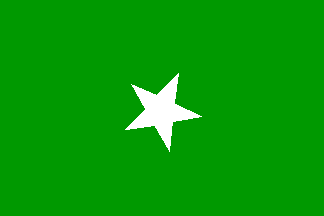 image by Ivan Sache, 30 January 2009
image by Ivan Sache, 30 January 2009
"Institución Educativa 'Nazario Restrepo'" was
founded by Priest Luis Diez Mesa in the Municipality of Viterbo,
Department of Caldas, on 4 February 1955, as "Colegio
'Nazario Restrepo'". The institute is named after Nazario
Restrepo, the priest who founded the settlement of Viterbo on 19
April 1911 by celebrating there a mass.
The flag of the institute, as shown graphically and described on
the website
of the institute, is green with a white star in the middle.
The text says that the original idea for the flag has to be
credited to teacher Javier Patiño Hincapié, who designed a
green flag of unspecified dimensions, crossed by a red arrow and
the Latin motto "Sursun cum laetitia" (Quicker with
joy), and a white star above the arrow.
The upper left part of the emblem of the institute shows on a
green field a book surmounted by an arrow and a star, all white.
Green represents the hope placed by the community into the youth.
The white star represents the purity of the students' heart.
Note: The horizontally divided yellow-blue-yellow flag with a
white star in the middle, shown on the front page of the website
of the institute, is the municipal flag of Viterbo.
Ivan Sache, 30 January 2009
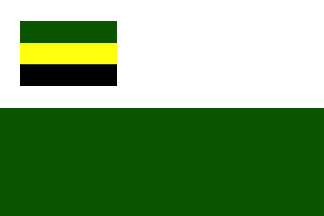 image by Ivan Sache, 02 September 2017
image by Ivan Sache, 02 September 2017
Institución Educativa Técnica Nacionalizada de Samacá was established on 3
March 1966 by Municipal Agreement, as Colegio de Bachillerato Municipal de
Samacá. The institute was transferred to the Boyacá Department on 11 December
1968 by Ordinance No. 49 and to the State on 5 August 1986 by Agreement No. 69.
Institución Educativa Técnica Nacionalizada de Samacá was established on 22
January 2009 by Resolution No. 129, as the merger of Colegio Nacionalizado,
Concentración Urbana Jaime Castro, Concentración Julio Flórez, Cedeboy, and
Escuelas Las Fábricas, Divino Niño, El Valle, Rincón Santo, Churuvita,
Infiernito, Mamonal, Blanca Nieves and El Quite.
The flag of I.E.T.N. de Samacá is horizontally divided white-green, with the
flag of Samacá (horizontally divided green-yellow-black) placed in the white
stripe close to the hoist.
White is a symbol of purity, peace and transparency.
Green is a symbol of the spiritual and material fertility of the Samacá valley
and hope placed in the youth.
Source:
Institute's website
Ivan Sache, 02 September 2017
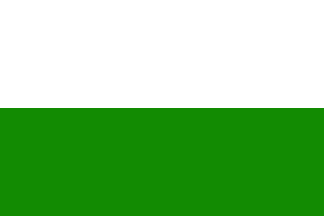 image by Ivan Sache, 11 January 2019
image by Ivan Sache, 11 January 2019
The flag of Institución Educativa Técnico Superior de Neiva (Huila
Department) is composed of two colors equally arranged horizontally, green and
white. Green is a symbol of hope while white is a symbol of peace and harmony.
http://tic-its.blogspot.com/p/horizonte-institucional-institucion.html, Ana
Rita Barreiro Duran's blog
Ivan Sache, 11 January 2019
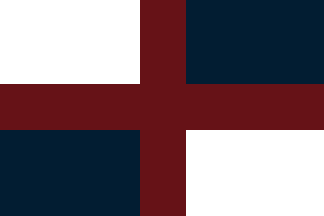 image by Ivan Sache, 3 January 2021
image by Ivan Sache, 3 January 2021
Newman School was established in 1991 in Cajicá, Bogotá, as Colegio Cardenal
John Newman.
The school is named for the British theologian and poet Henry
Newman (1801-1890), author of "The Idea of a University Defined and
Illustrated", created Cardinal deacon of San Giorgio al Velabro in 1879 by Pope
Leo XIII and canonized in 2019 by Pope Francis.
The flag of Newman
School, designed in 2000 by student Santiago Corredor, is quartered white-blue
by a thick red cross.
White, a symbol of transparency and clarity, represents
the ideal of spiritual discipline recommended by Newman to search the truth.
Blue, a symbol of universality, represents the school's central objective, to
educate citizens of the world.
Red, forming a cross, recalls the cardinal's
motto; "Cor ad cor loquitur"; "To Speak from Heart to Heart", and
represents the formation of heart in love.
https://www.newmanschool.edu.co/el-colegio_2018
School website
Ivan Sache,
3 January 2021
 image by Ivan Sache, 18 January 2009
image by Ivan Sache, 18 January 2009
"Colegio 'Nicolás Esguerra'" was the first free
educational institute founded in Bogotá. In 1938, the Congress
issued Honour Law No. 35, whose Article 3 granted to the
institute the name of the the journalist, lawyer and diplomat
Nicolás Esguerra (1832-1923).
The flag of the institute, as shown graphically on the website
of the institute, is horizontally divided green-white.
Ivan Sache, 18 January 2009
 image by Ivan Sache, 10 January 2004
image by Ivan Sache, 10 January 2004
The College is located on Giron, Santander department. Its
flag is horizontally divided white-light blue (azul).
Source:
www.voluntad.com.co,
located by Dov Gutterman.
Ivan Sache, 10 January 2004
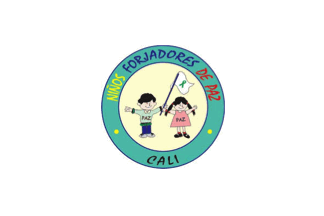 image by Ivan Sache, 3 January 2021
image by Ivan Sache, 3 January 2021
Niños Forjadores do Paz (Peace Forging Children) is a NGO established in 1996
by Organización Educativa Tenorio Herrera (OETH).
The association is mostly
composed of students from the three schools operated by OETH, Colegio Mayor
Alférez Real, Colegio Los Ángeles San Fernando, and Colegio Comercial de
Palmira-OETH.
Organization website
The flag of Niños Forjadores do Paz is white with the organization's emblem in
the center.
these photos
Ivan Sache, 3 January 2021
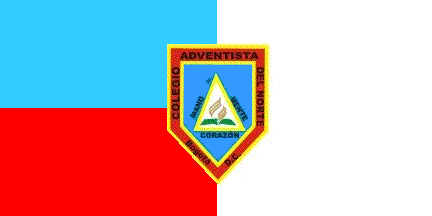 image by Ivan Sache, 9 January 2009
image by Ivan Sache, 9 January 2009
"Colegio Adventisto del Norte" was founded in 1984
in Bogotá by the Seventh-day Adventist Church, as "Colegio
Integral de Enseñanza Cristiana", and took its today's name
in 1992.
The flag of the institute, as shown graphically and described on
the website
of the institute, is white with two light blue and red
rectangles placed along the hoist and the emblem of the institute
in the middle of the flag.
The blue rectangle represents the Adventist education, projected
to heavens.
The red rectangle represents the blood sacrificed by Jesus for the
reconciliation of mankind and God.
The white square represents a transformed life, symbol
of divine justice and redemption.
The emblem of the institute is a symbol of faith representing the
Christian philosophy and education taught in the institute. The
shield is blue, bordered by a red pentagon outlined in
yellow, representing the five continents covered by the Adventist
teaching, charged with the black writing "COLEGIO ADVENTISTA
DEL NORTE Bogotá D.C." The emblem is charged with a white
triangle outlined in yellow and charged with the emblem of the
Adventist Church, made of a golden flame representing the Holy
Spirit, a white cross representing Jesus, and a green book
representing the Bible, the base and source of all knowledge. The
triangle is surrounded by the black writing "MANO"
("hand", left), "MENTE" ("spirit",
right) and "CORAZÓN" ("heart", bottom),
exalting the integrity of the Adventist teaching.
Ivan Sache, 9 January 2009
 image by Ivan Sache, 31 January 2009
image by Ivan Sache, 31 January 2009
"Gimnasio del Norte" was founded on 31 October 2002
in Valledupar, Department of Cesar, by the educators Pedro Ángel
Daza Mendoza and Berenice Flórez de Daza.
The flag of the institute, as shown graphically on the website of the
institute, is vertically divided light blue-white.
Ivan Sache, 31 January 2009
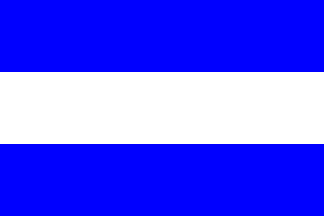 image by Ivan Sache, 7 February 2009
image by Ivan Sache, 7 February 2009
"Gimnasio Norte del Valle" was founded on 6 July
1977 in Roldanillo, Department of Valle del Cauca.
The flag of the institute, as shown graphically on the website of the
institute, is horizontally divided blue-white-blue.
Ivan Sache, 7 February 2009